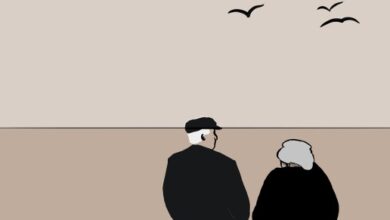VI— “The Stare’s Nest By My Window” by W. B. Yeats is the sixth in a seven-lyric poem called “Meditations in Time of Civil War” written during the Irish Civil War of 1922-23, which was the aftermath of their independence from the British. This is taken out of the most politically concerned and famous poetry collection, The Tower. This poem strikes at the core of Irish Nationalism and is an epitome of Yeats’ fear of losing the beauty of nature in the light of all the violence and bloodshed around him. The poem balances the gruesome aspect of the Civil War with the harmonious and regenerative imagery of nature and starlings building their nest in the dilapidated empty house.
The Stare’s Nest By My Window | Analysis, Lines 1-5
The bees build in the crevices
Of loosening masonry, and there
The mother birds bring grubs and flies.
My wall is loosening, honey bees
Come build in the empty house of the stare.
The poet begins with the imagery of nature taking over the empty houses. Considering that this was written during the Irish Civil War, the desolate houses take on a deeper and more violent meaning. This reflects back on the violence and how it leaves behind gaping holes within the civilization, which then becomes the house of starlings (stares, as in the dialect) who feed honey to their younglings. The phrase “my wall is loosening” might be referring to the structure of the society crumbling all around Yeats.
The Stare’s Nest By My Window | Analysis, Lines 6 – 10
We are closed in, and the key is turned
On our uncertainty; somewhere
A man is killed, or a house burned,
Yet no clear fact to be discerned:
Come build in the empty house of the stare
The poem then continues on to demonstrate the war and the violence of war in more detail, and how society is impacted by this. Not only is mankind slaughtering each other, but the land is also being affected. The poet is pointing toward the fact there is no reason behind this violence and that’s what makes it more horrifying. However, the poet asks to keep the violence aside, to enter the territory where violence doesn’t exist, only harmony and nature.
The Stare’s Nest By My Window | Analysis, Lines 7 – 15
A barricade of stone or of wood;
Some fourteen days of civil war;
Last night they trundled down the road
That dead young soldier in his blood:
Come build in the empty house of the stare.
The poem moves into the more terrifying aspects of war, and the poet introduces the cruel and brutal elements in detail. Here, the poet is dismayed and despairing over the loss of life, and how the war leaves behind the bodies of young people. There is so much life that is lost that the poet is almost turned away from the beauty of life, and the only thing tethering him to life is the nest of a starling in an empty house. Only the rejuvenating and repairing aspect of nature manages to salvage the beauty of life for the poet. And thus, the poet is inviting the readers toward the healing aspect of nature and leaving aside the war. What is clear from this poem is that “the poetry of earth is ceasing never,” and that Yeats associates the imagery of a starling bird feeding her youngling with the honey-bee, an epitome of harmony, life, and regeneration.
The Stare’s Nest By My Window | Analysis, Lines 16 – 20
We had fed the heart on fantasies,
The heart’s grown brutal from the fare,
More substance in our enmities
Than in our love; oh, honey-bees
Come build in the empty house of the stare.
Irish patriots would later turn on one another during the Civil War, exhibiting the lines “More substance in our enmities/ Than in our love,” their hearts still sincerely affected but frequently brutalised by fantasies. The troubles in Northern Ireland, which are still ongoing, contain remnants of love overpowering hatred in the shape of sectarian strife between Catholics and Protestants. This poem ends on a true plea to nature to heal what mankind has wrought apart.
The poetry contains a central theme and imagery of love and regeneration through honeybees and starlings building their nest in the crevices of empty houses, especially during the incessant violence among mankind, which leaves multiple houses desolate and empty, perfect for nature to take over. This image is Yeats’ way of overcoming the bitterness left behind by the Civil War, the very bitterness over such desolation and destruction led him to take shelter within the honey of imaginary bees. Yeats might be pondering over the cyclical pattern of life, and how human beings indulge in arbitrary bloodshed while the cycle goes on and the only thing that remains behind are honeybees and the starlings. Yeats’ poetry is political yet has a central notion of continuity of nature in the face of politics. Yeats lived during turbulent times and
In “A Stare’s nest by my Window,” more localised acts of violence and murder are focused on the struggle between order and chaos. The poet battles his own inner war against disorder in the poem, which describes the extremely detrimental effects of civil war while urging renewal, rebirth, and regeneration in “the empty house of the stare.” The poetry is political in the sense that there is a strong rejection of the idea that nationalism needs to be drought with war and violence. The poem frequently depicts images of destruction, such as “A man is killed, or a house burned,” and thus, the prospect of order returning to the land is tinged with “uncertainty.” Yeats’ own heart goes out to those birds that nourish rather than kill, and bees that build rather than destroy, in the midst of destructive violence and embittered hearts.
Yeats made an effort to reconcile some of these disagreements in his poems, but he frequently had to concede that such a synthesis was neither always conceivable nor even likely. However, he continued to interact with the world, despite how flawed it was, and he did so with a complicated temperament that could alternately hint at grace, freshness, and beauty with a distinct clamour against injustice, senility, and decay. Perhaps one should be thankful that many confrontations never came to a resolution during his times because it was these very conflicts that lent him “an old man’s frenzy” and inspired his most arduous struggles and moving poetry. However, one can only resonate with his poetry in the continuously turbulent world, even in the current times. Poetry is moving the world even today only because the universal theme of love and harmony prevails in the biggest of turmoils and conflicts.
The poem with its contrasting focus on nature with its inherent domesticity—honeybees building their hive in a starling’s empty nest—and the violence going on land, presents an interesting and politically compelling image. The repeating final line of every stanza of the poem itself is what makes it riveting. Alongside hostility, brutality, devastation, enmity, and murder, there also persists building, regeneration, tenderness, and love.



